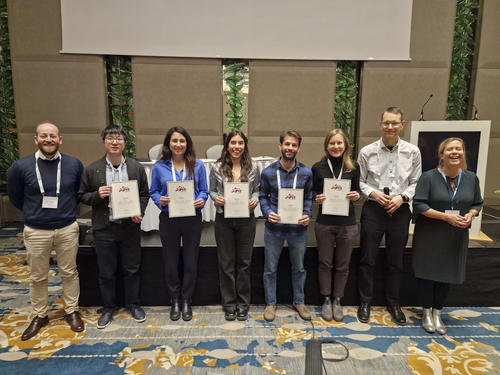Poster award winner at ESSB conference in Berlin
Congratulations to our postdoc Dr. Ruth Leben for being awarded for her poster on the topic "NAD(P)H-FLIM and
PHIP-based NMR identify metabolic alterations in human lymphoma cells after inhibition of NAD+ restoration" (Poster no. 106)
News vom 17.12.2024
The poster was presented at the inaugural conference of the European Society for Spatial Biology (ESSB e.V.) held in Berlin 12.+13. December 2024
Poster abstract:
The co-enzymes NAD(P)+/NAD(P)H are crucial for cellular metabolism and pathogen defense.Since the oxidized forms are autofluorescent and their fluorescence lifetime change with
the enzyme to which they bind to, they can serve as markers to monitor these life-sustaining
mechanisms, in a label-free manner and in vivo by fluorescence lifetime microscopy (FLIM).
However, interpreting NAD(P)H-FLIM data is challenging due to the low two-photon action
cross-sections and debated enzyme-bound fluorescence lifetimes (Sharick 2018, Blacker
2019, Chacko 2019, Leben 2019, Ranjit 2019).
Here we performed NAD(P)H-FLIM on human lymphoma cells using two-photon microscopy
and analyzed the data with our vector algebra algorithm (Leben 2019). In brief, the
measured fluorescence lifetimes of key NAD(P)H-dependent enzymes in solution were used
to benchmark the universal circle in the phasor plot. Our algorithm assigned each pixel in
the FLIM image to specific enzymes, creating maps of enzyme distribution and metabolic
activity. Due to similar lifetimes, we categorized enzyme-bound NAD(P)H into four groups:
unbound NAD(P)H, LDH-like, PDH-like, and NOX-bound, helping differentiate between metabolic
inactivity, anaerobic glycolysis, oxidative phosphorylation (OxPhos), and oxidative
burst/stress.
We challenged lymphoma cells by inhibiting the NAD+ salvage pathway, essential for regenerating
NAD+. Our NAD(P)H-FLIM data showed a significant increase in NAD(P)H activity,
indirectly indicating a reduced pool of freely available NAD(P)H. Enzyme maps revealed a
drastic reduction in NADH bound to the LDH group, suggesting decreased anaerobic glycolysis
with constant OxPhos, supported by the unchanged PDH-group binding. Additionally,
NOX activation significantly increased post-intervention.
Our findings, confirmed by PHIP-based NMR (Hövener 2018), underscore the efficacy of our
NAD(P)H-FLIM evaluation framework in capturing metabolic complexity in living cells and
tissues.
source: ESSB_Abstract_Book_web2
